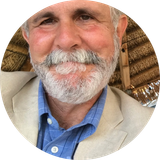Want to catch people’s attention? Lead with something tangible.

I met with a friend today who has told me about her course for years and years. Let's call it “Vital Emanation” (though that’s not really its name). For years, we have met, enjoyed good walks, and great conversation.
Periodically, she would tell me about her work on Vital Emanation. She was filming the lessons. She was putting together the website. She was delivering her first course.
Every so often, I would try to understand what it was about. I knew she was very smart, so it was probably about something interesting. But because the name and concepts felt so abstract, it really didn’t feel like something I needed to delve into. I could have done so to be nice; but that did not seem right.
I know this bothered her a lot, that I never wanted to do her course. “I find it puzzling that you don't want to know more about Vital Emanation,” she would say, and was clearly hurt. But somehow, it just never felt like something I needed to know about. The intangible words felt like air. And though there might well be something in there, I could not feel it.
From time to time, I would try to tell her: Perhaps if you could find a way to say what it was about... to the layperson, I mean... it would feel a little more compelling....” But somehow, this did not seem to gain traction with her. Still it was abstraction. “Vital Emanation....”
And again, she would tell me about the project. “It’s about consciousness,” she would say. That's as abstract as anything, I would think to myself. I wonder what it is about.
Finally today, after years, I told her once again how abstract it felt. Could she give me some concrete examples? What are the uses of this thing? What would be some outcomes for people? I was reaching for something tangible. Something that would spark the passerby.
And after all these years, she told me: Here are the concrete scenarios where this would make a difference if, say, you were having a conflict in your workplace. And here is how it would help to balance perspectives, or add creativity to a team. She gave example after example, each time spelling out the ways that her framework could make a difference for the people who applied it. Concrete, tangible, helpful. I got it!
And now, it all made sense to me. Vital Emanation was a simple framework that could be laid over countless situations, and be useful in many places. Once she gave me examples of real-life situations, it all sounded very reasonable and made a lot of sense.
Years of mentioning the name did nothing for me. But half an hour describing tangible outcomes, and it was a compelling set of ideas. And the examples sparked many engaging conversations and opportunities for me to apply the thinking to my own experience.
All these years, she had been describing her work from the outside in — by describing the abstract label she had given to it, she was hoping people would inspect the container. But people are generally too busy to inspect the contents of a container, if they are not yet sure it’s worth their time.
Instead, were she to talk about from the inside out — here are real-life scenarios you have probably encountered; here’s how these ways of thinking will help you there; and as a whole, the entire process is called Vital Emanation — she would have many, many more signups. I knew it. Because for many years as a friend, the label had held no energy for me. And yet once I knew what was inside the box, I was sparked and excited.
It’s something all of us can learn to improve: Using strong sense details and tangible examples. If we are big, abstract thinkers, it’s all the more tempting to feel that using big, broad ideas will convey big, broad concepts. “It’s about consciousness.” “It’s about dimensional change.” But the only reason the abstractions have any meaning to us is because of the concrete experiences we have had, and then associated with the labels.
If we think back to anything we, ourselves have learned, we will notice that it began with an experience. Something that shook or moved us. And then, as we assimilated knowledge about that area, we became able to make a broader map of that territory. Finally, we could describe an entire set of profound experiences with a few words. But to breathe life back into those words for others, we have to bring people into experiences of their own first.
In speaking about your work, your business, or your projects: see if you can practice leading with tangible results. And see if it doesn’t spark much quicker engagement, attention, and curiosity. Let me know!




